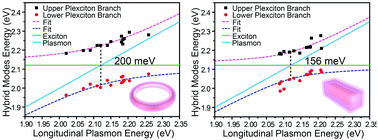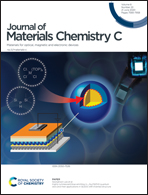Strong plasmon–exciton coupling in bimetallic nanorings and nanocuboids†
Abstract
Strong light–matter interaction at room temperature is significant for quantum optics, especially for exploring advanced nano-optical devices. We report herein a light–matter interaction in the strong coupling regime between plasmons confined within a single isolated bimetallic nanoring or nanocuboid and molecular excitons of J-aggregates under ambient conditions. We show that a bimetallic Au@Ag nanoring possesses larger enhanced electric field distribution than a Au@Ag nanocuboid, which enables bimetallic nanorings to couple with more excitons efficiently and overcome the large dissipation of the hybrid system. A large vacuum Rabi splitting of 200 meV was observed in this Au@Ag nanoring/J-aggregate hybrid. Finite-difference time-domain (FDTD) simulation and theoretical calculation show that there are ∼196 excitons in each Au@Ag nanoring/J-aggregate hybrid contributing to the coupling with a coupling constant of ∼111.3 meV, which is much higher than that of a single Au@Ag nanocuboid. Our work demonstrates that strong coupling can be realized via the enlargement of the overlap volume between excitons and plasmons, which can maximize the number of excitons contributing to coupling, giving rise to giant vacuum Rabi splitting. Our result provides additional flexibility to the experimental realization of novel plexcitonic architectures to attain strong coupling in an easily integrated and ultracompact platform.



 Please wait while we load your content...
Please wait while we load your content...